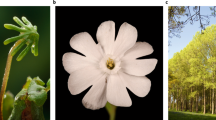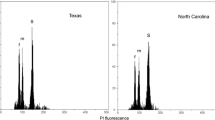Abstract
The evolution of dioecy (separate males and females) from hermaphroditism in higher plants has puzzled evolutionary biologists since Darwin1. An initial step towards the evolution of dioecy may often be the evolution and persistence of females within otherwise hermaphroditic populations1–6. This step is difficult because a nuclear gene for being female must provide a greater than twofold increase in female fitness for females and hermaphrodites to coexist stably5–8. It is unlikely that seed production would increase this much as a result of not producing pollen. Here I show that in buffalo gourd, seeds from females survive their first year in nature 2.8 times more frequently than seeds from hermaphrodites, apparently because seeds from hermaphrodites are mostly self-fertilized and selfing severely reduces seedling survival.
This is a preview of subscription content, access via your institution
Access options
Subscribe to this journal
Receive 51 print issues and online access
$199.00 per year
only $3.90 per issue
Buy this article
- Purchase on Springer Link
- Instant access to full article PDF
Prices may be subject to local taxes which are calculated during checkout
Similar content being viewed by others
References
Darwin, C. The Different Forms of Flowers on Plants of the Same Species (Murray, London, 1877).
Arroyo, M. T. K. & Raven, P. H. Evolution 29, 500–511 (1975).
Ross, M. D. Evolution 32, 174–188 (1978).
Lewis, D. Biol. Rev. 17, 46–67 (1942).
Lloyd, D. G. Genetica 45, 325–339 (1975).
Charlesworth, B. & Charlesworth, D. Am. Nat. 112, 975–997 (1978).
Lewis, D. New Phytol. 40, 56–63 (1941).
Charnov, E. L., Maynard Smith, J. & Bull, J. J. Nature 263, 125–126 (1976).
Dossey, B. F., Bemis, W. P. & Scheerens, J. C. J. Hered. 72, 355–356 (1981).
Yousef, Y. thesis, Univ. Arizona (1976).
Ba-Amer, M. A. & Bemis, W. P. Econ. Bot. 3, 297–299 (1968).
Alves Costa, J. T. & Bemis, W. P. Turrialba 22, 207–209 (1972).
Sokal, R. R. & Rohlf, F. J. Biometry (Freeman, New York, 1981).
Lande, R. & Schemske, D. W. Evolution 39, 24 (1985).
Charlesworth, D. & Charlesworth, B. A. Rev. Ecol. Syst. 18, 237–268 (1987).
Holsinger, K. E., Feldman, M. W. & Christiansen, F. B. Am. Nat. 124, 446–453 (1984).
Maynard Smith, J. The Evolution of Sex (Cambridge University Press, 1976).
Williams, G. C. Sex and Evolution (Princeton University Press, 1975).
Bishop, Y. M. M., Fienberg, S. E. & Holland, P. W. Discrete Multivariate Analysis (MIT, Cambridge, Massachusetts, 1977).
Author information
Authors and Affiliations
Rights and permissions
About this article
Cite this article
Kohn, J. Why be female?. Nature 335, 431–433 (1988). https://doi.org/10.1038/335431a0
Received:
Accepted:
Issue Date:
DOI: https://doi.org/10.1038/335431a0
This article is cited by
-
High lifetime inbreeding depression counteracts the reproductive assurance benefit of selfing in a mass-flowering shrub
BMC Evolutionary Biology (2014)
-
Mating system, sex ratio, and persistence of females in the gynodioecious shrub Daphne laureola L. (Thymelaeaceae)
Heredity (2005)
-
The cost of selfing inEncyclia cochleata (Orchidaceae)
Plant Systematics and Evolution (1999)
-
Floral biology and reproductive ecology ofClusia nemorosa (Clusiaceae) in northeastern Brazil
Plant Systematics and Evolution (1998)
-
Outcrossing rates and inferred levels of inbreeding depression in gynodioecious Cucurbita foetidissima (Cucurbitaceae)
Heredity (1995)
Comments
By submitting a comment you agree to abide by our Terms and Community Guidelines. If you find something abusive or that does not comply with our terms or guidelines please flag it as inappropriate.



